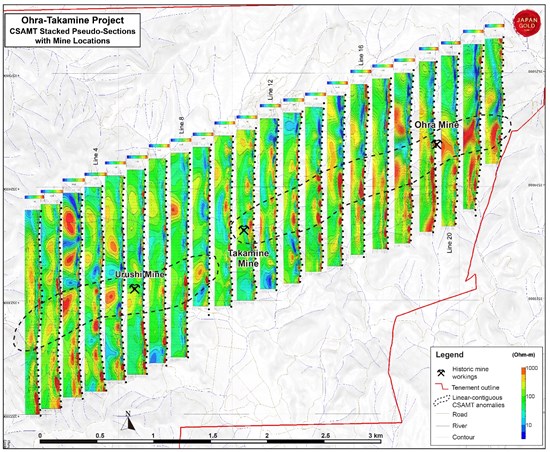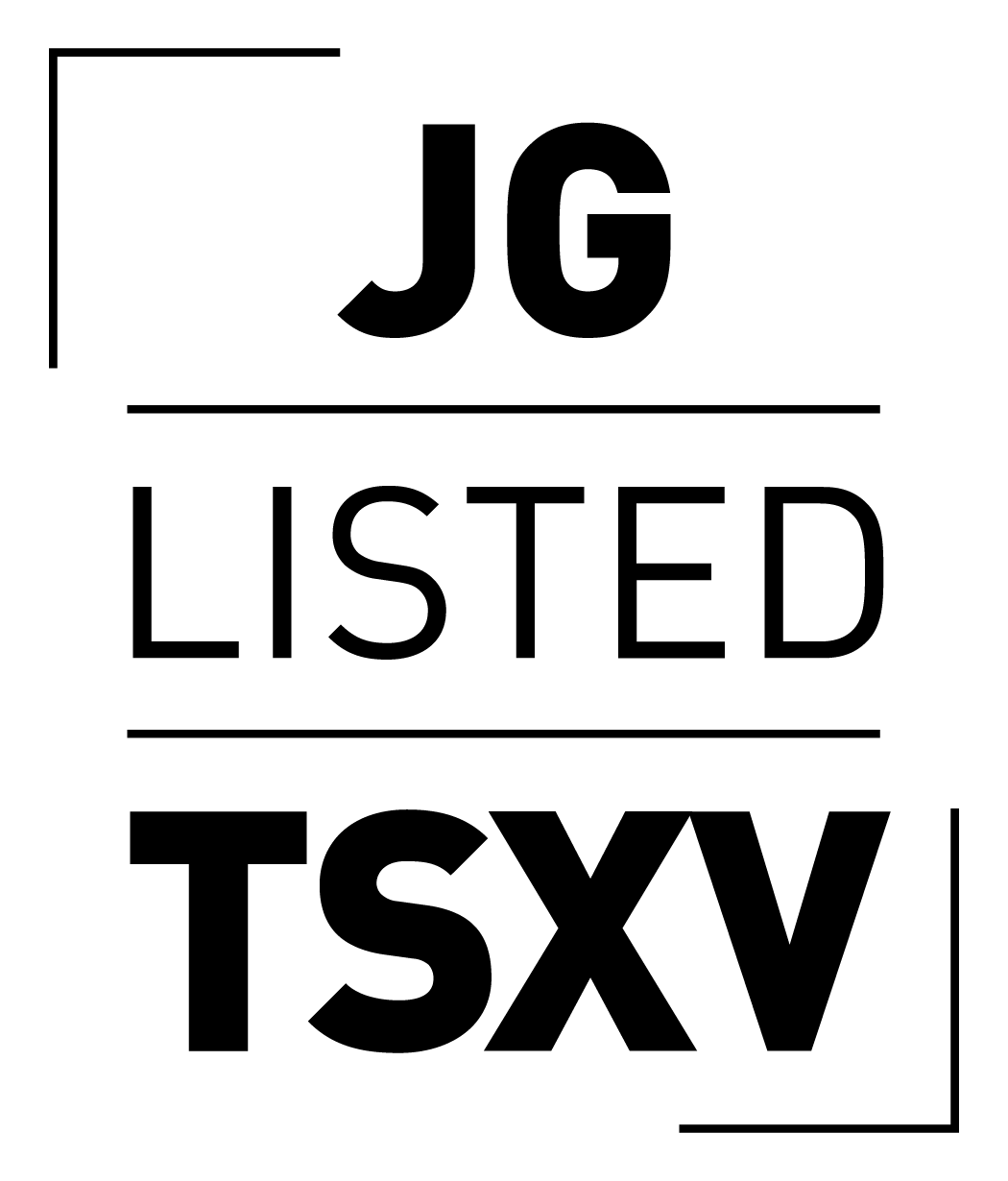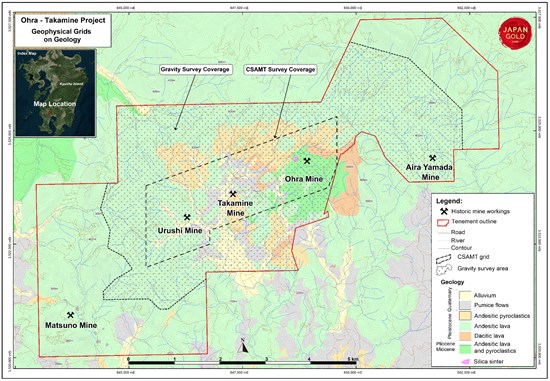Vancouver, British Columbia--(Newsfile Corp. - April 8, 2020) - Japan Gold Corp. (the "Company") (TSXV: JG) (OTCQB: JGLDF) is pleased to announce encouraging results from geophysical work programs completed at its Ohra-Takamine Gold Project in southern Kyushu. Comprehensive programs completed during January and February, 2020 covered a substantial portion of the 8-kilometer Ohra-Takamine historic mine corridor and included controlled source audio-frequency magnetotellurics ("CSAMT") and detailed ground-gravity geophysical surveys.
Highlights:
- A 35 line-kilometer, grid-based, CSAMT geophysical survey was completed along a 4.2 kilometer portion of the Ohra-Takamine Mine corridor
- The CSAMT geophysical survey at the Ohra-Takamine Project was undertaken to identify zones of sub-surface electrical resistivity and conductivity, representing silicification and clay alteration related to epithermal vein systems
- Results of the CSAMT survey at Ohra-Takamine are very encouraging and have defined a number of linear kilometric-scale, contiguous resistive zones (CSAMT anomalies), locally extending to depth across the survey area
- Prospect-scale gravity readings were collected over an 8 by 4 kilometer area with nominal 60 to 100 metre spacings along access roads and ridgelines and merged with Geological Survey of Japan gravity data to produce a new suite of processed gravity images
- Results of the gravity survey define basement uplift or doming along a northeast oriented structural zone along which the mine corridor is hosted
- Geophysical surveys completed to date are adding a vital third dimension to the epithermal targets at the Ohra-Takamine Project.
The Ohra-Takamine Gold Prospect lies within the highly gold endowed Southern Kyushu Epithermal Gold Province, and hosts five historic gold mines, the Matsuno, Urushi, Takamine, Ohra, and Aira Yamada Mines, which define a northeast oriented structural corridor, Figure 1. In excess of 11 million ounces of gold has been produced from high-grade low-sulphidation epithermal gold deposits in the province; notable producers include; the Hishikari Mine with 7.8 million ounces of gold produced to date at average grades of 30-40 g/t Au1; Kushikino Mine, 1.8 million ounces at 6.7 g/t Au; Yamagano Mine, 910,000 ounces at 17.4 g/t Au; and the Okuchi Mine with 714,000 ounces at 13.6 g/t Au2,3.
CSAMT Survey
A 35 line-kilometer, grid-based, controlled source audio-frequency magnetotellurics (CSAMT) geophysical survey was completed by Zonge Geophysics Pty. Ltd. during January and February 2020, over a 4.2 kilometer-length of the Ohra-Takamine Mine corridor. The survey comprises 22 individual, north-south orientated CSAMT grid lines varying from 1.5 to 1.8 kilometers in length, spaced 200 metres apart. The grid is staggered along an east-northeast orientation, parallel to the trend of the historic mine corridor and mapped alteration system.
Gravity Survey
Bouguer gravity data was acquired by Haines Surveys Pty. Ltd. during January and February 2020, over an approximate 8 by 4-kilometer area, centred on the Urushi-Takamine-Ohra mine corridor. 973 gravity station readings were acquired at nominal 60 to 100 metre spacings along access roads and ridgelines and merged with gravity data from the Geological Survey of Japan to produce a suite of processed gravity images; including a terrain corrected Bouguer anomaly map, first order trend removed, vertical derivative, Gaussian residual, Hanning filtered residual and horizontal gradient maps.
Conclusions from CSAMT and Gravity Geophysical Surveys
The CSAMT geophysical survey at the Ohra-Takamine Gold Project was undertaken to identify zones of sub-surface electrical resistivity and conductivity, representing silicification and clay alteration respectively, related to epithermal vein systems.
Results of the CSAMT survey at Ohra-Takamine are very encouraging and have defined a number of linear kilometric-scale, contiguous resistive zones (CSAMT anomalies), locally extending to depth across the surveyed area, Figure 2. In the eastern part of the grid, a contiguous, linear resistive zone is defined across multiple sections, coincident and parallel to the trend of mineralisation at the Takamine Mine and extending to the northeast, through and beyond the Ohra Mine. This resistive zone coincides with surface mapped hydrothermal clay alteration, which typically forms above and laterally around the upper portions of large epithermal vein systems. A similar, contiguous resistivity zone commences 600 meters to the east of the Urushi Mine, extending in a westerly direction below the mine to the edge of the CSAMT grid. The resistivity anomalies mapped along the Urushi Mine trend, occur largely below a veneer of younger volcanic ash cover and alluvium. Additional, linear resistivity anomalies have been defined to the north and south of the main mine corridor; their trends are both sub-parallel, and oblique, to the trend of the historical workings in these mines.
The definition of structural architecture and faulting which allows pathways for hydrothermal fluid flow, and subsequent quartz vein formation is a key factor in the interpretation of CSAMT results. With this in mind, detailed gravity surveying was undertaken to further define faulting. Initial findings from gravity show the Urushi, Takamine and Ohra Mines are located on the northwest shoulder of a prominent gravity ridge, Figure 3. The spatial relationship between gravity highs and the major low-sulphidation epithermal gold deposits in the province is well described in the literature, and uplift or doming of the underlying basement, producing gravity anomalies, is interpreted as a key factor in the development of deep-seated fracture pathways for hydrothermal fluid flow, and subsequent quartz vein development in these mines.
In the coming weeks the gravity data collected by the Company will undergo additional processing to contour rapid changes in gravity gradient, providing more definition of the fault architecture related to gold mineralisation.
Soil and Rock Chip Sampling
An extensive 6.4 by 3.3-kilometer grid-based soil sampling program comprising 1,470 soil and 188 rock samples was completed in March 2020 along the mine corridor, and recently dispatched for analysis. The samples will undergo gold and multi-element geochemical assay and spectral clay analysis and will be included in the compilation of a comprehensive geological, geochemical, and geophysical data set. Assay results from the soil and rock chip samples are expected within the next 4 weeks.
Geophysical surveys completed to date are adding a vital third dimension to the epithermal targets at the Ohra-Takamine Project. In the coming weeks, additional structural information from further gravity processing and systematic surface geochemical and alteration maps will provide vectors for ground truthing of anomalies, and refinement of new drill targets.
References
1 Sumitomo Metal Mining Co., LTD. website, production as of end of March 2019.
2 Watanabe Y, 2005. Late Cenozoic evolution of epithermal gold metallogenic provinces in Kyushu, Japan. Mineralium Deposita (2005) 40: pp 307-323
3 Garwin, S.G. et al. 2005. Tectonic setting, Geology, and gold and copper mineralization in the Cenozoic magmatic arcs of Southeast Asia and the West Pacific. Economic Geology 100th Anniversary Vol. pp 891-930
Qualified Person
The technical information in this news release has been reviewed and approved by Japan Gold's Vice President of Exploration and Country Manager, Andrew Rowe, BAppSc, FAusIMM, FSEG, who is a Qualified Person as defined by National Instrument 43-101.
On behalf of the Board of Japan Gold Corp.
"John Proust"
Chairman & CEO
About Japan Gold Corp.
Japan Gold Corp. is a Canadian mineral exploration company focused solely on gold exploration across the three largest islands of Japan: Hokkaido, Honshu and Kyushu. The Company has a country-wide alliance with Barrick Gold Corporation to jointly explore, develop and mine certain gold mineral properties and mining projects. The Company holds a portfolio of 30 gold projects which cover areas with known gold occurrences, a history of mining and are prospective for high-grade epithermal gold mineralization. Japan Gold's leadership team represent decades of resource industry and business experience, and the Company has recruited geologists, drillers and technical advisors with experience exploring and operating in Japan. More information is available at www.japangold.com or by email at
For further information, please contact:
John Proust
Chairman & CEO
Phone: 778-725-1491
Email:
Cautionary Note
Neither the TSX Venture Exchange nor its Regulation Services Provider (as such term is defined in the policies of the TSX Venture Exchange) accepts responsibility for the adequacy or accuracy of this release. This news release contains forward-looking statements relating to expected or anticipated future events and anticipated results related to future partnerships and the Company's 2020 gold exploration program. These statements are forward-looking in nature and, as a result, are subject to certain risks and uncertainties that include, but are not limited to, general economic, market and business conditions; competition for qualified staff; the regulatory process and actions; technical issues; new legislation; potential delays or changes in plans; working in a new political jurisdiction; results of exploration; the timing and granting of prospecting rights; the Company's ability to execute and implement future plans, arrange or conclude a joint-venture or partnership; and the occurrence of unexpected events. Actual results achieved may differ from the information provided herein and, consequently, readers are advised not to place undue reliance on forward-looking information. The forward-looking information contained herein speaks only as of the date of this News Release. The Company disclaims any intention or obligation to update or revise forward‐looking information or to explain any material difference between such and subsequent actual events, except as required by applicable law.
Figure 1. Ohra-Takamine Gold Project, CSAMT and gravity geophysical survey locations on geology.
To view an enhanced version of Figure 1, please visit:
https://orders.newsfilecorp.com/files/5665/54261_a0ebcaad749bbb64_001full.jpg

Figure 2. Ohra-Takamine Gold Project, CSAMT stacked pseudo-sections with mine locations.
To view an enhanced version of Figure 2, please visit:
https://orders.newsfilecorp.com/files/5665/54261_a0ebcaad749bbb64_002full.jpg

Figure 3. Ohra-Takamine Gold Project, Terrain corrected Bouguer gravity FOTR image with mine locations.
To view an enhanced version of Figure 3, please visit:
https://orders.newsfilecorp.com/files/5665/54261_a0ebcaad749bbb64_003full.jpg

To view the source version of this press release, please visit https://www.newsfilecorp.com/release/54261



